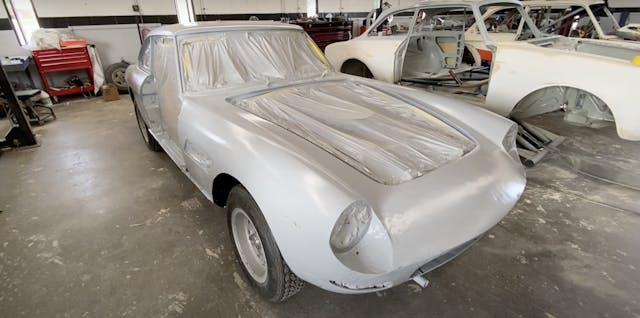Media | Articles
Bright paint, dark secrets: What a little filler can hide
The proverbial “polished turd” is a pitfall into which many car enthusiasts eventually fall. Stories vary in severity, which is to say that some recently purchased rides arrive with an undisclosed patch of rust under the trunk carpet, while others are somehow more Bondo than metal. Even elite cars like Ferraris can hide surprises, and when we recently came across a particularly egregious example, it reminded us that the ugly truth is sometimes deeper than pretty paint.
The cars in question are two Ferrari 330s, in for repair at the great Tom Yang’s restoration shop in Hudson, New York. Yang runs his one-man outfit specializing in Ferraris, and he’s seen a lot throughout his years in that world. When a collector purchased a bright red over tan leather 2+2 back in July, he requested it be painted to match his late-model Ferrari. Tearing into the car to prep for the color change revealed some sour news.
Sadly, the poor thing was packed with body filler in some key areas. Yang was not surprised. “It happens all the time,” he told us after shutting off his welder to chat for minute. “There is rarely good news under paint. Rust-free cars exist and are out there, but we are looking at cars that are 50 to 60 years old. What car survives that long and hasn’t seen some damage, no matter how small?”
Not long after Yang got to work on the car, he began to suspect there was something going on underneath. The paint in the passenger door sill was not adhering properly, but even a good paint meter wouldn’t have been much help for the buyer ahead of time. “Paint meters can only do so much, and even if it says there is filler, or maxes out, that is only about 35-thousandths thick. So does that mean it is 1/8″ filler or 2″? There really isn’t a way to tell until the paint comes off.”
Marketplace
Buy and sell classics with confidence
It’s all too easy to find these issues after the fact, and it happens all the time. We spoke with several different restorers, and the common factor whether at the high end of the market or the low end is that owners are cost-conscious. In reality, open-checkbook restorations or cost-no-object builds are extremely rare. Bodywork is one of those labor-intensive jobs that costs roughly the same whether you are working on a 1985 Chevrolet pickup or Pre-war Duesenberg, and no type of car or brand is immune to body filler.
So how does one avoid the inevitable? Yang shared with us expertise on how to dodge such body bullets:
Follow the paper trail
If the car was restored, find out who did it and pick up the phone. Any restoration shop will likely remember the car and the owner and has no reason to tell you anything but the truth about the work that was done.
Ask for restoration pictures
Request to see the metal work. Digital photography makes it easy for restorers to document the work of a job in progress. Most upstanding shops should be champing at the bit to show off the quality of their work; if that isn’t the case, find out why.
Take your time with inspection
No matter how you slice it, buying at auction is tough. Auctions rarely offer enough time to perform full due diligence, so the best advice is to use all the time you can. Hire a neutral party and get real expert eyes on the car. The cost of a pre-purchase inspection sounds off-putting until you are out five times that amount because the car was not what you expected or wanted.
“Too good to be true” exists
This one speaks for itself. Don’t be so distracted by the thought of something that you gloss over the reality. A 60-year old car is just that, which means it’s likely to have 60-year-old-car problems.
Any vintage car can end up a can of worms if not properly cared for, which means it is up to us as enthusiasts to collectively hold ourselves to a higher standard and help keep our beloved vehicles on the road for many generations. Shoddy bodywork glazed over with shiny paint is not the best way to preserve items we are so lovingly trying to keep alive. This Ferrari 330GT will be a lot more polish than turd when Yang is done with it, and though not everyone is a professional, proper care should be everyone’s goal.










